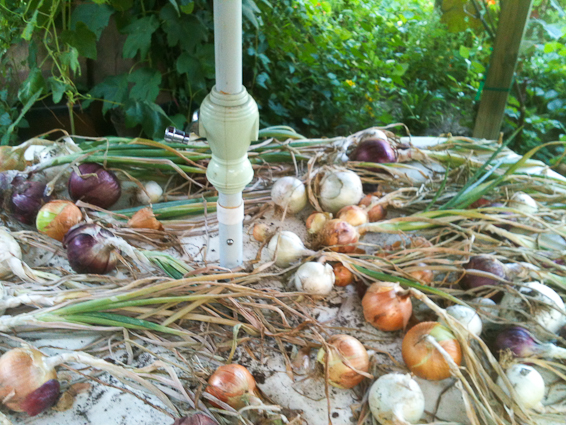- Home
- How to Grow Vegetables A-Z
- Growing Onions
- Harvesting Onions
Harvesting Onions
Harvesting
onions should be done when the tops start to turn brown and fall over. Don’t try harvesting
onions by pulling them up by the tops or you can damage them, making them
susceptible to fungus when in storage.
 First Batch of Onions Curing on My Picnic Table
First Batch of Onions Curing on My Picnic TableRather, fork them up gently, brush the dirt off the roots (don’t damage or remove the skin), and lay them on the surface of the ground for two or three days to “cure”. Lay them out in rows like shingles, with the tops of one row covering the bulb of the next. This will prevent the hot sun from causing sunscald damage to the bulbs.
If your onions are ready to harvest but it looks like it’s going to rain in the next few
days, you’ll need to bring them indoors to cure. Lay them out on newspapers in
a warm dry place. It takes longer to cure onions indoors (up to two weeks), because
the sun isn’t helping you out. 65-70% humidity and 75-80 degrees F. is ideal for curing onions.
Onions are cured when the skins are loose and dry. Leave as much of the skins on as you can, as the skins help protect the onion during storage.
Whatever you do, don’t let harvested onions get wet (!), either by washing them off or by inadvertently leaving them out in the rain. Also, don’t forget to turn the irrigation off if they’re curing in the field, too.
When the tops are fully dried and your onions are ready for storage, you can
- cut the tops off about an inch above the onion, for storage in orchard drawers or other airy place
- leave about 6" of stem on the onion, and make an onion string
- leave the whole stem on and make an onion braid
For more on braiding or stringing onions, visit the Storing Onions page below.
Read more about growing onions in these Related Articles:
- How to Grow Onions
Why choosing the right variety for your latitude is critical, and optimal soil and climate conditions for growing onions. - Planting Onions
How and when to plant onions, whether from seed, sets or transplants (and what the difference is). - Onion Diseases
The most common onion diseases and how to prevent them. - Onion Bolting
How to prevent onions from bolting, and what to do if they have already started going to seed. - Storing Onions
There are several ways to store onions over the winter months, including braiding, use of orchard racks, and pantyhose! - Types of Onions
Types and varieties of onions, and why day length matters. - Growing Onions from Seed
How to successfully grow onions from seed, including start times, transplant times and more.
Help share the skills and spread the joy
of organic, nutrient-dense vegetable gardening, and please...
~ Like us on Facebook ~
Thank you... and have fun in your garden!
Affiliate Disclaimer
This website contains affiliate links to a few quality products I can genuinely recommend. I am here to serve you, not to sell you, and I do not write reviews for income or recommend anything I would not use myself. If you make a purchase using an affiliate link here, I may earn a commission but this will not affect your price. My participation in these programs allows me to earn money that helps support this site. If you have comments, questions or concerns about the affiliate or advertising programs, please Contact Me.Contact Us Page



